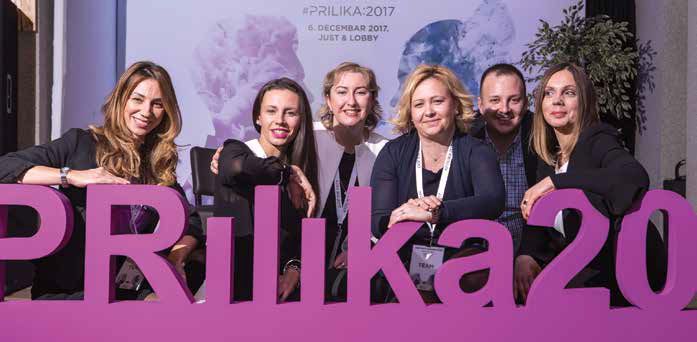There is a noticeable overlapping in the market, perhaps even the merging of the communications and marketing
branch, along with programming, which creates a new communication environment in which younger generations are successfully finding their way. This new creation imposes the need for industries to re-examine themselves and for the existing business models to change extensively. It looks like the change is coming “from below” as a result of the change in communication habits.

What is your share in the growth of creative industries in Serbia?
– Considering the big overlapping among the communications industry disciplines, it is difficult to specify the revenues that public relations generate, but based on this year’s Agency Report, compiled by Marketing Network (Marketing Mreža) in Serbia, we can say that the business revenues of 37 PR agencies, registered in Serbia, increased by more than 6% compared to the previous year. The Holmes Report talks about the global growth of more than 5%, wiht the total revenues amounting to about $11.7 billion. In short, the need for communication services is growing year-on-year, as does the importance of creative industry.
In which way does digitization affect your sector? Where do you see the benefits and where challenges for your members? How much is your industry exposed to global trends? How many domestic agencies are able to follow these trends, or impose their own solutions?
– Digitization came as a surprise to all industries, including communications – from finances and energy to healthcare and agriculture, with all processes going through digital transformation. Thanks to digitization, we have now a situation where the largest taxi company in the world does not own any of its vehicles, the largest tourist site does not own the facilities it rents, and the largest vendor of consumer goods does not have a warehouse. Digitization has not only changed the economic order, but it has also changed consumer habits. The fact that Amazon is the most visited website in America speaks in favour of the fact that nowadays fewer people are shopping in the traditional way.
All this has happened in the last ten years or so, and every change in society is inevitably reflected on communications. The word „communication“ is derived from the Latin word „communicare“ which, in translation, means „sharing“, that is exchanging information through speech, written language or digital communication channels, like today. New trends and transformations are creating new challenges for all of us who are involved in communications.
Just like the Chinese sign for the crisis consists of a symbol for problem and opportunity, so the digitization trend is both a challenge for us, as it also creates a lot of new possibilities. Compared to the tools and channels we had available before the digital era, today we can communicate with the target public in a variety of ways, and we can create a fuller, more intimate and better quality relationship with them. Thanks to digitization, today we can also direct messages to the right recipients with a far greater precision and with almost 100 percent success, and we can optimize resources and budgets. Nowadays, we have plenty of choices but there remains a challenge in terms of selecting the right approach and the way of using it.
It’s a challenge to understand trends, to work constantly on personal improvement and team development, and to use the experience and apply it in accordance with available contemporary methods. There is a noticeable overlapping in the market, perhaps even the merging of the communications and marketing branch, along with programming, which creates a new communication environment in which younger generations are successfully finding their way. This new creation imposes the need for industries to re-examine themselves and for the existing business models to change extensively. It looks like the change is coming “from below” as a result of the change in communication habits.
Domestic agencies are very successful in following everything that happens on the global stage and they are able to offer excellent digital analysis, while new services are created in existing agencies because there is a need for data analysis (so-called data science analytics), where ETF experts or IT developers have the decided advantage. Our agencies have a great success in combining creativity and originality, for which they are recognized and rewarded, and in conquering new channels and target groups through digital communication. An integrated concept, that links strategy design, creating content for social media in the service of communication and marketing on digital channels, has proven to be very successful. I am sure that there is great potential in this area, because we have excellent IT professionals and also very creative agencies, with well-designed communication strategies. This is, by all means, a winning combination for the future.
How much do changes in the digital sphere affect the established forms of corporate communications?
– Continuing from your previous question, we can easily deduce that there are many channels / links to end users – from traditional media and direct contact in real world to online media, social networks, applications and virtual reality. This abundance of „receivers“ has resulted in the fact that today an ordinary person receives information that is equivalent to 174 newspapers which is five times more than in the 1980s.
Some researchers claim that each of us are, consciously and unconsciously, exposed to about 1,500 brands on a daily basis (namely, the signs on the shops, the billboards we pass by every day, and even the logos that our brain registers on clothing, in magazines or on cups of coffee). These are impressive figures that tell us about how important the role of communication is in today’s society but at the same time, they give us a difficult task of fighting for audience attention to hear the messages of our companies.
Generation Z has already paved the way for corporate brands, and this way leads through the experience that engages us, and the added value that the brand gives its consumers. Prior to digitization, consumers were able to express their dissatisfaction with the brand only by refusing to buy it. Today, the consumer’s voice can be heard far, and sometimes even louder than the voice of the brand itself. This is the fact that has determined the direction of corporate communications toward developing their own media channels and the need to create their own, authentic story (popularly called storytelling).
What other important market trends can you tell us about?
– If we are already talking about the multitude of communication channels, we must mention the fact that the availability of digital channels turns each individual into a more or less powerful individual medium. This phenomenon was created by a large number of influencers, vloggers, bloggers, Instagrammers, and people who use personal communication channels and sometimes manage to gather an extremely large numbers of followers. A special phenomenon is the influence on children and young people as a result of the strong emotional connection with the mentioned group. Influencers easily occupy a position of supreme authority among young people and are far more influential than their parents or school. This communication channel is recognized as a growing opportunity for placing messages with high potential.
Also, digital channels increase the possibility of placing false news, as we have often had cases of so-called fake news in the past. Over the past few years, domestic and foreign markets have seen many communication crises that have emerged from completely inaccurate and unverified information. Sometimes even the highest state officials have used them, without checking whether they are true thus contributing to general delusions, as was the case with Donald Trump. Our profession is currently looking for an effective solution to this growing occurence.
We are going to deal with this and many other topics related to global trends at the upcoming communication conference, PRilika that will take place in Belgrade on 22nd November and is organized by the Serbian Public Relations Association.

How do these changes affect the need for education and what can you offer to your members in this respect?
– Digital transformation is happening very quickly, and everyone is expected to work on personal improvement and be constantly educated. Whether it’s technological possibilities, legislation or consumer habits, our profession testifies to the great changes that require continuous improvement. In addition to the annual professional conference, the Serbian Public Relations Association organizes free lectures and workshops under the auspices of our How2PR programme that covers various current topics and issues in our industry.
You have recently adopted the new Code, which, among other things, has a segment related to digital communications. What novelties does the Code contain and what obligations does it create for members? How often does the Court of Honour have the opportunity to discuss the violations of the Code?
– The aim of the Serbian Public Relations Association’s Professional Ethics Code is getting its members to adhere to the basic principles of morally justified and ethical behaviour. Since the nature of our work is related to public and general social interests, the Code implies that everybody who abides by it has to have personal responsibility to act in accordance with the highest ethical standards.
The Code’s content refers to good business practices in regard to the preservation of confidential information, and preventing dissemination of fake news and information. In the era of digital communication channels, the Court of Honour, as a working body within the DSOJ, has expanded the Code to include the most frequent example of breach of good practice – a popular phenomenon called ‘fake news’ .
Given that we have the Code that regulates the field of communication in this way, as an association, we are working on informing and educating PR professionals about the necessity of adhering to it and the need to report to the Court of Honour each of its violations by DSOJ members. This body receives two to three reports on violations of ethics every year.